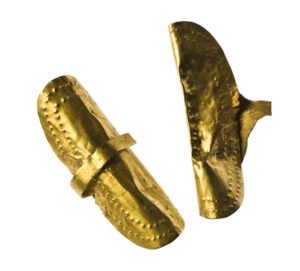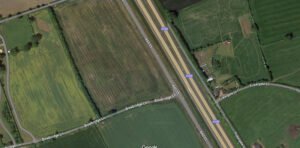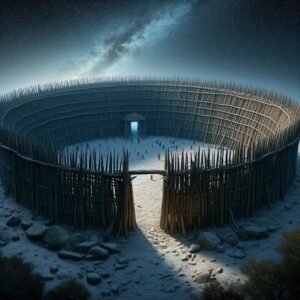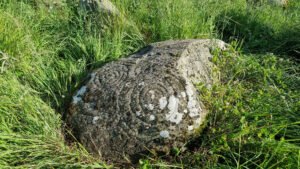These small, delicate gold objects are highly significant, they offer insight into the social status, trade connections, and cultural practices of early Bronze Age societies in Britain.
Category: Burial Mound
Mitchell Laithes Farm Ring Cairn and burial complex, Ossett, West Yorkshire
- By George in Barrow, Bronze Age, Burial Mound, Earthworks, Neolithic, Ring Cairn
The Bronze Age discoveries in Mitchell Laithes Farm, Ossett, West Yorkshire, offer an important glimpse into the region’s ancient past. Archaeological appraisals, particularly the one conducted in 2007 at Mitchell Laithes Rye Royds, have unearthed evidence of short episodes of occupation dating back to 3500-2000 BC.
Bowbridge Lane Late Bronze Age burial site, Catterick
- By George in Barrow, Bronze Age, Burial Mound, Iron Age, Roman
The excavation on the northern side of Bowbridge Lane as part of the A1 expansion revealed a significant archaeological site, with features indicative of Late Bronze Age funerary practices.
Marne Barracks Neolithic palisaded enclosure
- By George in Burial Mound, Enclosure, Neolithic
The recent discovery at Catterick has unveiled a significant Late Neolithic palisaded enclosure, shedding light on the prehistoric landscape of North Yorkshire. Excavations revealed two concentric sub-circular palisades, with the outermost having a diameter of up to 200 meters and the inner one measuring approximately 175 meters in diameter.
Little Meg Stone Circle
- By George in Burial Mound, Neolithic, Stone Circle
Little Meg Stone Circle, also known as Maughanby Circle, is a small and ancient monument located near the village of Little Salkeld in Cumbria, England. It consists of eleven large kerb stones that probably surrounded a Bronze Age kerb cairn, a type of burial mound
- Bronze Age
- Iron Age
- Roman
- Dark Ages
- Early Christian
- Viking
- Saxon
- Medieval
- Vitrified Fort
- Archaeology Guide
- Guide – Introduction to Critical Thinking in Archaeological Research
- Guide – Challenging Assumptions with Free Thinking
- Guide – Congruence in Archaeological Interpretation: Holistic Analysis
- Guide – Critical Thinking: Lack of Evidence Does Not Mean Evidence of Lack
- Guide – Critical Thinking: The Simple Assumption
- Guide – Applying critical thinking to historic and archaeological research
- Guide – Empathic Archaeology Introduction
- Guide – Landscape Archaeology Introduction
- Guide – What is Landscape Archaeology?
- Guide – The Flora and Fauna of Prehistoric Britain
- Guide: Landscape Archaeology: The Geology of Thornborough
- Guide – Landscape Archaeology: The Geological Environment of Britain
- Guide – Landscape Archaeology: Post-Ice Age Landscape of Thornborough
- Guide – Archaeological Periods in Western Europe
- Guide – Visible Remains
- Guide – Hidden Remains
- Guide – Getting Started
- Guide – Landscape Features
- Guide – Agricultural practices through time
- Guide – Introduction to Glacial Archaeology
- Guide: In Depth – Church Doors and Windows
- Guide – Mining
- Guide – Archaeological Terms
- Guide – Glossary
- Latin Translation – Choosing the meaning of AUG
- Reports
- An introduction to Brigantian Druidry
- Brigantia during the Dark Ages
- Celtic Heads
- Cleave Dyke Defensive System, North Yorkshire
- Finding Bardon – An Arthurian Quest
- Early Christian syncretism and how the old ones hid amongst the new religion
- Rome: The Emperors Claim to Divinity
- Syncretism through the ages
- The Border Reivers
- The Gallus Frontier – Brigantia against the Romans
- The growth of Christianity 50AD – 1100AD
- The Kingdom of Venutius
- The use of the word Lady in relation to water related structures
- The walled gardens of Brigantia
- Yorkshire’s “Sacred Vale” – The Dawn of Brigantia
- The Brigantes of Europe
- Spain
- Galicia
- Biefing – The Myth of Breogán and the Tower of Heracles
- Briefing – Galicia’s Political History and Separatist Sentiment
- Briefing – Geography and Geology of Galicia
- Briefing – Design of Galician Hillforts
- Briefing – Roman Interaction with Galicia and the Iberian Peninsula
- Church of Santa María de Cambre, Cambre near A Coruña
 PAS North Yorkshire
PAS North Yorkshire
- NLM-5EB8D1 BROOCH ROMAN 19 February 2025Copper alloy brooch. Hod Hill brooch, Mackreth type HOD HILL 4.b3. A small bifurcated head is rolled forward to retain pin gear [lost]. An uppermost part of the strip below this bears a single transverse rib. Below this, a nearly square plate has four vertical ribs and small waisted wings. The lower bow is moulded […]
- NLM-5ED6DB BROOCH ROMAN 19 February 2025Copper alloy brooch fragment. Cast lower bow and unpierced catch plate from a bow brooch with a narrow rounded bow, possibly a Colchester brooch, Mackreth type C 2. Suggested date: Early Roman, 43-75Length: 26.2mm, Width: 3.3mm, Thickness (bow): 2.7mm, Weight: 2.21gms
- NLM-5FD83F COIN ROMAN 19 February 2025Copper alloy coin. Possibly an as indeterminate, Early Roman issue of 43-200, with drilled hole near edge at 10 O’clock[?] obverse.Obverse description: bust probably rightReverse description: possibly a figure.Diameter: 24mm, Weight: 4.82gms, die axis: possibly 12
Research Links
Recent Reports
Periods
Categories
- Abbey (3)
- Agriculture (1)
- Air Mapping (2)
- Air Photography (2)
- Amphitheatre (1)
- Angle (2)
- Archaeology (77)
- Articles (102)
- AUG (1)
- Augustus (1)
- Barrow (7)
- Battle (1)
- Beacon (1)
- Biography (2)
- Bridge (5)
- Briefing (8)
- Brigantia (87)
- Brigantia Espania (7)
- Brigantian Druidry (1)
- Broch (1)
- Burial Mound (5)
- Castle (5)
- Celtic Industry (1)
- Celtic Life (8)
- Celtic Trade (1)
- Chimney (1)
- Church (23)
- Critical Thinking (7)
- Crosses (1)
- Cursus (2)
- Defensive structure (1)
- Dyke (5)
- Earthworks (21)
- Empathic Archaeology (5)
- Enclosure (8)
- Festivals (2)
- Field Systems (15)
- Fieldwalking (2)
- Finds (24)
- Altar (9)
- Axe (1)
- Celtic Head (7)
- Clock (1)
- Curse Tablet (1)
- Hair Braid – Ring (1)
- Statue (1)
- Folly (4)
- Ford (2)
- Fort (14)
- Free Thinking (7)
- Geography (2)
- Geology (2)
- Geophysics (4)
- Glacial Archaeology (2)
- Gods (9)
- Gothic (2)
- Guide (44)
- Hall (1)
- Henge (15)
- Henge Capital of Britain (10)
- Hill Figure (3)
- Hill Fort (39)
- Hospital (1)
- House (1)
- Inscription (4)
- Landscape Archaeology (17)
- Landscape feature (2)
- Latin (3)
- Latin translation (5)
- Leaders (26)
- Breogans (2)
- LiDAR (1)
- Maps (6)
- Marching Camp (5)
- Market (1)
- Mining (4)
- Motte and Bailey (4)
- Mound (1)
- Myth and Legend (2)
- Period (258)
- Anglo-saxon (3)
- Bronze Age (22)
- Dark Ages (12)
- Dark Ages Brigantia (2)
- Early Christian (28)
- Georgian (2)
- Iron Age (113)
- Jacobite (4)
- Medieval (47)
- Medieval Brigantia (3)
- Mesolithic (6)
- Neolithic (30)
- Norman (36)
- Palaeolithic (3)
- Roman (80)
- Saxon (6)
- Stuart (3)
- Tudor (7)
- Phalera (1)
- Photography (6)
- Priory (2)
- Regional Surveys (6)
- Religious Orders (3)
- Reports (62)
- Research (9)
- Research Tools (4)
- Ring Cairn (1)
- Ritual walkway/pilrimage path (1)
- River Works (1)
- Rock Art (1)
- Roman Villa (1)
- Scotland (3)
- Smelting (1)
- Socratic Thought (1)
- Spain (3)
- Standing Stones (4)
- Stone Circle (4)
- Stories of Brigantia (3)
- Suspect (1)
- The Premonstratensians (2)
- Tower (6)
- Trade (1)
- Translation (5)
- Tribes (24)
- Uncategorized (43)
- Undated (7)
- Viking (3)
- Vitrified Fort (23)
- Walking Guides (2)
- Walled Garden (1)
- Well (1)







